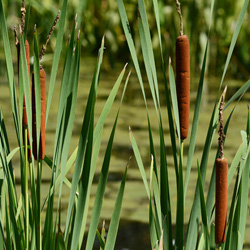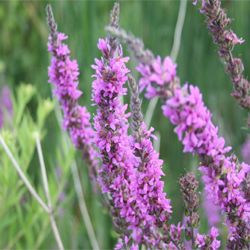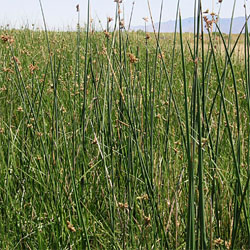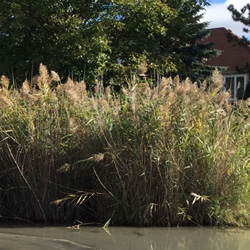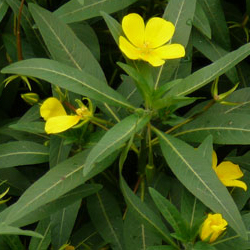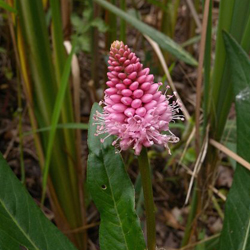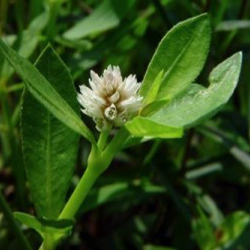Emergent Weeds
Cattails
Cattails are common emergent aquatic plants found throughout North America. They are native perennials that grow in moist soil and have adapted to grow in water depths up to a few feet. Cattails have a unique flowering spike and flat, blade-like leaves that reach heights from 3 to 10 feet. Cattails are found commonly in large marshes and on the edge of ponds. Cattails can provide a nesting habitat for some birds and waterfowl species as well as brood rearing cover for ducks and fish. They help prevent the erosion of dams and pond banks. Yet, with their many potential benefits, cattails frequently become pests interfering with water flow, hindering fishing, swimming, boating and can reduce plant diversity in an aquatic ecosystem.
Purple Loosestrife
The purple loosestrife is an erect perennial with opposite or whorled leaves, its thick taproot supports up to 50 stems that can reach a height of 6 feet. Purple loosestrife is an aquatic to semi-aquatic plant with distinctive purple flower that makes it easy to recognize. This invasive plant thrives in marshes, wet meadows, streams, riverbanks, lakeshores and ditches, but can also survive in dry conditions.
Shoreline Weeds
Shoreline weeds, such as rushes or varying types of nuisance grass can thrive in or near bodies of water. They can provide habitat for wild birds and other smaller animals as well as nesting cover for fish. As beneficial as these plants are for the ecosystem, excessive shoreline weeds can become a nuisance. If not controlled, these plants will create a thick colony that can interfere with water flow, swimming, and recreation as well as reduce plant diversity.
Phragmites
Sometimes known as Common Reed, phragmites are one of the most widespread plants on Earth and are found in marsh systems world-wide. It is an erect perennial grass 6 to 20 feet tall that remains standing all season and is fairly easily recognized by its plume-like inflorescence seed heads later in the Summer Months. There are native and non-native phragmites. Native phragmites grow in low density stands, often intermixed with other native plants. They have more delicate stems with a red or chestnut color towards the base and are smooth to the touch, its leaves are lighter in color than the non-native species. Non-native Phagmites typically form very dense stands which include both live stems and standing dead steams from the previous year. The leaves are blue-green with very rigid culms and a rougher stalk texture than native Phragmites.
Creeping Water Primrose
Creeping water primrose is a perennial aquatic plant whose long stems creep over mud or shallow water, sometimes forming dense mats which float on the water surface. Named for its yellow primrose-like flowers, while its long, oval leaves resemble those of willows. The water primrose typically grows in slow-flowing rivers, marshes, ditches, streams and shorelines, as well as being able to grow in water up to 6 feet deep with its stems potentially extending 30 inches above the water surface.
Water Smartweed
Water smartweed plants grow in wetlands, muddy soils, borders of small lakes and ponds, shallow water and deep ditches in much of North America. It has thick spikes of bright pink flowers borne on a thick stalk above the alternate, oval, leathery green leaves. The flowers bloom from June to October and are then replaced by a single seed. When growing on land, the erect stems reach up to 3 feet tall. The leaves are 2 ½ – 8 inches long and ½ – 2 inches across with sharp, pointed tips. Plants growing underwater have hairless stems up to 6 feet long, and submerged round-tipped leaves. The root system is formed with rhizomes from which new plants can develop.
Alligator Weed
Alligator weed is a non-native perennial, sprawling, floating plant with hollow stems, often growing in a dense tangled mass and rooted in waters up to 8 feet deep. They also grow from the shoreline and are occasionally free-floating. Its fleshy stems grow horizontally and can reach a length of 30 feet. The leaves are arranged in opposite pairs or whorls with a distinctive midrib and range in size from 1 to 3 inches. Alligator weed flowers appear in early spring. The flowers have no petals, but five white or colorless sepals up to ¼-inch long. Alligator weed plants growing in aquatic habitats tend to have stems that are hollow and larger than those of plants growing on land. Alligator weed in the United States grows throughout the southeast region, Texas, California and parts of the Midwest. Dense mats of alligator weed displace native aquatic and shoreline vegetation and negatively impact aquatic systems by decreasing water flow, increasing sediment, shading submerged plants, reducing oxygen levels, filling in and choking open water habitats. Alligator weed mats also provide a breeding ground for mosquitoes.

